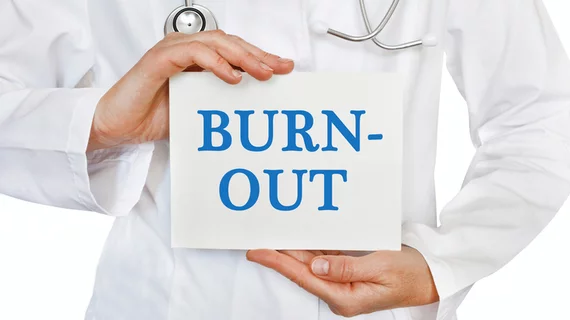‘Moral injury’ is prevalent among interventional radiologists, with healthcare corporatization 1 contributor
“Moral injury” is prevalent among interventional radiologists and it is having a direct negative impact on their quality of life, according to new survey data.
The phenomenon is defined as a “a deep sense of transgression including feelings of shame, grief, meaninglessness, and remorse from having violated core moral beliefs,” experts wrote in Academic Radiology [1]. In healthcare, moral injury typically manifests as lingering regret after organizational constraints prevent physicians from acting in the best interest of their patients.
Researchers aimed to gauge whether IR professionals face this challenge, distributing an anonymous 29-question survey using the Society of Interventional Radiology’s Connect Open Forum website, among other platforms. A total of 365 physicians completed the questionnaire, with more than 61% suffering from moral injury. The greatest contributors, according to IR professionals, included ineffective leadership, barriers to patient care, corporatization of medicine, nonphysician administration, performing “futile” procedures, turf battles and reduced resources.
“Previous studies have demonstrated an association between [moral injury] and medical errors,” Andrew J. Woerner, MD, with the Section of Vascular and Interventional Radiology at the University of Washington in Seattle, and colleagues wrote Nov. 3. “Reducing MI may improve physician wellness, as well as the safety and quality of patient care.”
Researchers administered the survey over five days in spring of 2023. Respondents skewed heavily male (82%) and included 299 practicing IRs (82%) and 66 radiologists-in-training (18%). Most practiced in academic settings (40%), followed by community (33%), hybrid (23%) or “other” (4%). Average quality of life on a 100-point scale was 71.1, suggestive of a “good” QoL score, which was significantly different in the moral injury subgroup (68 vs. 77). About 61% of respondents scored greater than 36 on the scale and were categorized as having profession-related moral injury, the authors noted.
In the free-text response section, interventional radiologists suggested several possible ways to address moral injury. Those included increased autonomy, less bureaucracy, more administrative support, physician-directed leadership, adequate staffing, and changes to the medical system. More than 69% of respondents completed the open-ended response to the question: What do you believe would limit/alleviate MI most? Physician unionization, transparency with insurance companies, more time off, and leaving medicine/retirement also were cited as potential remedies.
“These proposed solutions may provide benefit in counteracting [moral injury] as they aim to combat external or systemic barriers or return control to the healthcare practitioner,” Woerner and colleagues wrote. “Unfortunately, many of these proposed solutions are challenging, and perhaps impractical, to execute as they require tackling complex cultural, systemic, and institutional structures, which are beyond the scope of this study.”
Read more in Academic Radiology at the link below.

